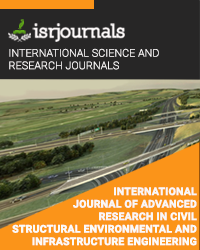review on comparison of energy absorption in steel fibre reinforced conrete polypropylene fibre reinforced conretehybrid fibre reinforced conrete
Malar,Vignesh.P,D.Dhanush Raaj
Published in International Journal of Advanced Research in Civil,Structural,Environmental and Infrastructure Engineering and Developing
ISSN: 2320-723X Impact Factor:1.7 Volume:3 Issue:1 Year: 20 March,2017 Pages:441-446

Abstract
The objectives of the current research is to study the durability properties of M30 grade of concrete reinforced individually with 4 per cent of steel and polypropylene fibres, respectively, as well as with hybrid fibres consisting of 2 per cent steel and 2 per cent polypropylene fibres, respectively, and to evaluate their strength at 7, 14, 21 and 28 days. It has been observed that many investigators have used a maximum dosage of 2 per cent by volume of cement for a single fibre. The investigation here pertains to hybrid fibres consisting of two classes of fibres, namely, steel and polypropylene. As per the literature evidence, for each fibre a dosage of 2 per cent has been adopted. Therefore in hybrid fibre-reinforced concrete the fibre content was 4 per cent. For comparison the same dosage of 4% was adopted in individual cases too. Also, addition of more fibres reduces cracking and improves corrosion resistance. Moreover, fibre reinforcement also serves to improve the shear resistance of concrete. In the recent past, investigators attempted to enhance the mechanical properties of fibre reinforced concrete using fibre hybridization. Different types of fibres in various combinations have been employed with varying sizes of concrete specimens. Though enhancement in the mechanical properties of HyFRC has been reported through fibre hybridization, but there exists little understanding of hybrid fibre composites and the information obtainable at present is still scanty. Hence, this investigation was planned to study the flexural behavior of Hybrid FRC containing hybrids of steel and polypropylene fibres. Addition of different proportions of steel and polypropylene fibres to concrete has been investigated to evaluate the mechanical properties of Hybrid FRC. Tests under compression and flexure have been conducted on concrete specimens containing different percentages of combination of steel and polypropylene fibres.
Kewords
energy absorption, Steel Fibre Reinforced Conrete; Polypropylene Fibre Reinforced Conrete;Hybrid Fibre Reinforced Conrete.
Reference
IS 383, (1970), “Specification for coarse and fine aggregates from natural sources for concrete.” Bureau of Indian Standards, New Delhi, India, Second revision. IS 516, (1959), “Indian standard methods of tests for strength of concrete,” Bureau of Indian Standards, New Delhi, India. IS 10262, (2009), “Recommended guidelines for concrete mix design,” Bureau of Indian standards, New Delhi, India. Balaguru, P. and S.P. Shah, (1992), “Fiber Reinforced Cement Composites,” McGraw International Edition, New York. Banthia, N. and Soleimani, S.M., (2005), “Flexural Response of Hybrid Fiber-reinforced Cementitious Composites,” ACI Materials Journal, Vol. 102, pp. 382-9. Banthia, N. and Sappakittipakorn, M., (2007), “Toughness Enhancement in Steel Fibre Reinforced Concrete through Fiber Hybridization,” Cement and Concrete Research, Vol. 37, pp. 1366-72. Hoff, G.C., (1986), “Use of steel fiber reinforced concrete in bridge decks and pavements, steel fiber concrete,” Elsevier Applied Sciences Publishers Ltd., pp. 67 – 108. Mohammadi, Y., Singh, S.P., Kaushik, S.K., (2008), “Properties of steel fibrous concrete containing mixed fibres in fresh and hardened state,” Construction and Building Materials, Vol. 22, pp. 956-75. Patodi, S. C. and Kulkarni, C. V., (2012), “Performance evaluation of hybrid fiber reinforced concrete matrix,” International Journal of Engineering Research and Applications (IJERA) ISSN: 2248-9622, Vol. 2, Issue 5, September-October, pp. 1856-1863. Ramadevi, V. and Venkatesh Babu, D.L., (2012), “Flexural behaviour of hybrid (steel and polypropylene) fibre reinforced concrete beams,” European Journal of Scientific Research, ISSN 1450 – 216, Vol. 70, No. 1, pp. 81 – 87. Sivakumar, A. and Santhanam M., (2007), “Mechanical properties of high strength concrete reinforced with metallic and non-metallic fibres,” Cement and Concrete Composites Vol. 29, pp. 603-8.

